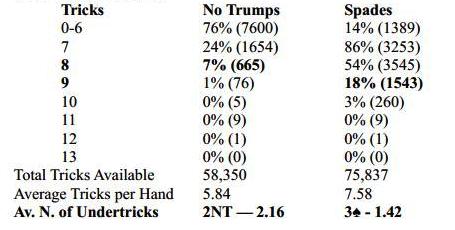Source: 4th EUROPEAN OPEN BRIDGE CHAMPIONSHIPS Sanremo, Italia
[ilink url=”http://csbnews.org/new/?p=25075″]PART 1[/ilink] [ilink url=”http://csbnews.org/new/bridge-software-to-analize-situations-part-2/?lang=en”]PART 2[/ilink]
You know the hand. Partner makes a 20-22 HCP balanced 2NT opening and you are looking at this miserable collection:
![]() 9 7 6 5 2
9 7 6 5 2 ![]() 8 3
8 3 ![]() 9 6 5
9 6 5 ![]() 6 4 2
6 4 2
What should you do? This question was asked of me some time ago and I analysed it in detail by running 5,000 hands through a random hand generator and Deep Finesse. Of course, I mentioned this in the Bulletin Office and it sparked some discussion.
I was sure that I would be able to find my original work as I have every data file going back to 1988 on my computer but of course I couldn’t find it so I ran the analysis again. My computer slaved away for many many hours as I increased the data set to 10,000 hands. The constraints for opener’s hand were 20-21 with any 4-4-3-2, 4-3-3-3 or 5-3-3-2 or any 22 without a five-card suit. Percentages are Cumulative
Percentages are Cumulative
Clearly transferring is a long term winner. There are of course occasions where partner will super-accept but even then you can make 4![]() or more 2.7% of the time, adding a nice bonus when you do get to game.
or more 2.7% of the time, adding a nice bonus when you do get to game.
The obvious caveats apply:
• Deep Finesse’s analysis is double dummy so finding every honour card and picking all singleton honours offside;
• Deep Finesse always finds the optimal lead against every contract no matter how obscure it may be;
It would be interesting to have people’s views on whether leads against no-trumps tend to be more accurate than against suits, which would again skew the results.
THE LAST WORD —3NT OR FOUR OF A MAJOR ANALYSIS
Those who know me well may believe that I generally like the last word (And the first and the second…Ed). And so it may be with the discussion of what to do with any 4-3-3-3 and game values opposite a 15-17 1NT opening. An unsigned article in the Bulletin suggested that the analysis may in fact be skewed by the possibility of the 1NT opener holding a five-card major and that he would always bid the hand according to time-honoured principles of Stayman etc.
I set my computer, and now perhaps people may understand why I bring a second one to bridge tournaments, on the slavish task of analysing North holds any 4-3-3-3 with game values with South holding a 5-3-3-2 with the major being the five-card suit and here are the conclusions.
 I must thank Herman De Wael, who has pointed out two significant issues with my earlier analysis. Firstly, the analysis is generally skewed towards teams and this is certainly correct. However, more important, he directed me to analyse how many hands declarer can make 3NT and NOT make 4
I must thank Herman De Wael, who has pointed out two significant issues with my earlier analysis. Firstly, the analysis is generally skewed towards teams and this is certainly correct. However, more important, he directed me to analyse how many hands declarer can make 3NT and NOT make 4![]() and vice versa, how many times 4
and vice versa, how many times 4![]() will make and 3NT will fail.
will make and 3NT will fail.
The software that I use has in fact got a module for this analysis built into it. In the analysis above there you will:
• Make 3NT 793 times on hands where you do not make 4![]() ; and
; and
• Make 4![]() only 339 times on hands where you fail in 3NT.
only 339 times on hands where you fail in 3NT.
So with any 4-3-3-3 it seems best to simply bid 3NT than Stayman for four or five card majors and hope to play a team with our anonymous contributor at the other table.
Esta entrada también está disponible en: Spanish

